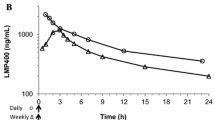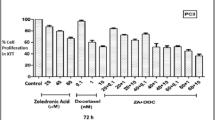Abstract
Purpose
Preclinical evaluation is essential for a rational design of combination chemotherapy as some agents, with known mechanisms of action and non-overlapping toxicities may increase the therapeutic index of anticancer drugs, whose clinical success is hindered by side effects and drug resistance. The present study investigated new drug combinations with potential outcome for the treatment of metastatic prostate cancer. This final clinical stage exhibits predominantly hormone-refractory prostate cancer (HRPC) cells but also a minority of hormone responsive cells.
Methods
Growth inhibition activity of simultaneous and sequential combinations was evaluated by resazurin assay. In vitro evaluation of synergism, additivity, or antagonism, against prostate cancer cell lines, was performed by the median effect analysis. The importance of dosage, exposure time, drug ratio, and type of treatment were investigated and compared.
Results
Most simultaneous combinations of two drugs with different mechanisms of action or of two topoisomerase II inhibitors resulted in mild antagonism of antiproliferative effects, particularly notorious at high cell death. Imatinib–mitoxantrone and ciprofloxacin–etoposide combinations were exceptions, as they yielded additivity and dose reduction index (DRI) values of 2.6 and 3.5-fold for mitoxantrone and etoposide, respectively. Sequential combinations (ciprofloxacin or imatinib pre-treatment) revealed additive growth inhibition effects, translated in much higher DRI values (from 7.0 to 15.3-fold). Moderate synergism was restricted to sequential ciprofloxacin combinations at high cell death.
Conclusions
Ciprofloxacin and imatinib significantly improve growth inhibition activity of standard antineoplastic drugs in a schedule-dependent manner and, therefore, may have an important role as adjuvant therapeutic agents in a clinical setting.




Similar content being viewed by others
References
Goodin S, Rao KV, DiPaola RS (2002) State-of-the-art treatment of metastatic hormone-refractory prostate cancer. Oncologist 7:360–370
Sonpavde G, Hutson TE, Berry WR (2006) Hormone refractory prostate cancer: management and advances. Cancer Treat Rev 32:90–100
Di Lorenzo G, Autorino R, De Laurentiis M, Bianco R, Lauria R, Giordano A, De Sio M, D’Armiento M, Bianco AR, De Placido S (2003) Is there a standard chemotherapeutic regimen for hormone-refractory prostate cancer? Present and future approaches in the management of the disease. Tumori 89:349–360
Kamat AM, DeHaven JI, Lamm DL (1999) Quinolone antibiotics: a potential adjunct to intravesical chemotherapy for bladder cancer. Urology 54:56–61
El-Rayes BF, Grignon R, Aslam N, Aranha O, Sarkar FH (2002) Ciprofloxacin inhibits cell growth and synergises the effect of etoposide in hormone resistant prostate cancer cells. Int J Oncol 21:207–211
Aranha O, Grignon R, Fernandes N, McDonnell TJ, Wood DP Jr, Sarkar FH (2003) Suppression of human prostate cancer cell growth by ciprofloxacin is associated with cell cycle arrest and apoptosis. Int J Oncol 22:787–794
Hubert A, Lyass O, Pode D, Gabizon A (2000) Doxil (Caelyx): an exploratory study with pharmacokinetics in patients with hormone-refractory prostate cancer. Anticancer Drugs 11:123–127
Hande KR (2008) Topoisomerase II inhibitors. Update Cancer Ther 3:13–26
Hande KR (1998) Etoposide: four decades of development of a topoisomerase II inhibitor. Eur J Cancer 34:1514–1521
Kamradt JM, Pienta KJ (2000) Etoposide in prostate cancer. Expert Opin Pharmacother 1:271–275
Vlahovic G, Ponce AM, Rabbani Z, Salahuddin FK, Zgonjanin L, Spasojevic I, Vujaskovic Z, Dewhirst MW (2007) Treatment with imatinib improves drug delivery and efficacy in NSCLC xenografts. Br J Cancer 97:735–740
Rao K, Goodin S, Levitt MJ, Dave N, Shih WJ, Lin Y, Capanna T, Doyle-Lindrud S, Juvidian P, DiPaola RS (2005) A phase II trial of imatinib mesylate in patients with prostate specific antigen progression after local therapy for prostate cancer. Prostate 62:115–122
Hande KR (1998) Clinical applications of anticancer drugs targeted to topoisomerase II. Biochim Biophys Acta 1400:173–184
Tannock IF, Osoba D, Stockler MR, Ernst DS, Neville AJ, Moore MJ, Armitage GR, Wilson JJ, Venner PM, Coppin CM, Murphy KC (1996) Chemotherapy with mitoxantrone plus prednisone or prednisone alone for symptomatic hormone-resistant prostate cancer: a Canadian randomized trial with palliative end points. J Clin Oncol 14:1756–1764
Zhou XJ, Rahmani R (1992) Preclinical and clinical pharmacology of vinca alkaloids. Drugs 44(Suppl 4):1–16 (discussion 66–19)
Hardman JG, Limbird LE, Gilman AG (2001) Goodman LSPbot: Goodman & Gilman’s the pharmacological basis of therapeutics. In: Hardman JG, Limbird LE (eds)/Alfred Goodman Gilman (consulting ed) 10th edn. McGraw-Hill, New York, London
Pinto AC, Moreira JN, Simoes S (2009) Ciprofloxacin sensitizes hormone-refractory prostate cancer cell lines to doxorubicin and docetaxel treatment on a schedule-dependent manner. Cancer Chemother Pharmacol 64:445–454
Chou TC, Talalay P (1983) Analysis of combined drug effects: a new look at a very old problem. Trends Pharmacol Sci 4:450–454
Chou TC, Talalay P (1984) Quantitative analysis of dose-effect relationships: the combined effects of multiple drugs or enzyme inhibitors. Adv Enzyme Regul 22:27–55
Chou TC (1994) Assessment of synergistic and antagonistic effects of chemotherapeutic agents in vitro. Contrib Gynecol Obstet 19:91–107
Budman DR, Calabro A, Kreis W (2002) Synergistic and antagonistic combinations of drugs in human prostate cancer cell lines in vitro. Anticancer Drugs 13:1011–1016
Chou TC, Tan QH, Sirotnak FM (1993) Quantitation of the synergistic interaction of edatrexate and cisplatin in vitro. Cancer Chemother Pharmacol 31:259–264
Kreis W, Budman DR, Calabro A (2001) A reexamination of PSC 833 (Valspodar) as a cytotoxic agent and in combination with anticancer agents. Cancer Chemother Pharmacol 47:78–82
Wampler GL, Carter WH Jr, Campbell ED, Keefe PA (1992) Relationships between various uses of antineoplastic drug-interaction terms. Cancer Chemother Pharmacol 31:111–117
Capranico G, Binaschi M, Borgnetto ME, Zunino F, Palumbo M (1997) A protein-mediated mechanism for the DNA sequence-specific action of topoisomerase II poisons. Trends Pharmacol Sci 18:323–329
Elsea SH, Westergaard M, Burden DA, Lomenick JP, Osheroff N (1997) Quinolones share a common interaction domain on topoisomerase II with other DNA cleavage-enhancing antineoplastic drugs. Biochemistry 36:2919–2924
Bakshi RP, Galande S, Muniyappa K (2001) Functional and regulatory characteristics of eukaryotic type II DNA topoisomerase. Crit Rev Biochem Mol Biol 36:1–37
Montecucco A, Biamonti G (2007) Cellular response to etoposide treatment. Cancer Lett 252:9–18
van Brussel JP, van Steenbrugge GJ, Romijn JC, Schroder FH, Mickisch GH (1999) Chemosensitivity of prostate cancer cell lines and expression of multidrug resistance-related proteins. Eur J Cancer 35:664–671
Barrett JF, Gootz TD, McGuirk PR, Farrell CA, Sokolowski SA (1989) Use of in vitro topoisomerase II assays for studying quinolone antibacterial agents. Antimicrob Agents Chemother 33:1697–1703
Anderson VE, Zaniewski RP, Kaczmarek FS, Gootz TD, Osheroff N (1999) Quinolones inhibit DNA religation mediated by Staphylococcus aureus topoisomerase IV. Changes in drug mechanism across evolutionary boundaries. J Biol Chem 274:35927–35932
Bromberg KD, Burgin AB, Osheroff N (2003) A two-drug model for etoposide action against human topoisomerase IIalpha. J Biol Chem 278:7406–7412
Liu WM, Joel SP (2003) The schedule-dependent effects of etoposide in leukaemic cell lines: a function of concentration and duration. Cancer Chemother Pharmacol 51:291–296
Bromberg KD, Burgin AB, Osheroff N (2003) Quinolone action against human topoisomerase IIalpha: stimulation of enzyme-mediated double-stranded DNA cleavage. Biochemistry 42:3393–3398
Boland MP, Fitzgerald KA, O’Neill LA (2000) Topoisomerase II is required for mitoxantrone to signal nuclear factor kappa B activation in HL60 cells. J Biol Chem 275:25231–25238
Leroy D, Kajava AV, Frei C, Gasser SM (2001) Analysis of etoposide binding to subdomains of human DNA topoisomerase II alpha in the absence of DNA. Biochemistry 40:1624–1634
Buchdunger E, O’Reilly T, Wood J (2002) Pharmacology of imatinib (STI571). Eur J Cancer 38(Suppl 5):28–36
Kubler HR, van Randenborgh H, Treiber U, Wutzler S, Battistel C, Lehmer A, Wagenpfeil S, Hartung R, Paul R (2005) In vitro cytotoxic effects of imatinib in combination with anticancer drugs in human prostate cancer cell lines. Prostate 63:385–394
Ostman A, Heldin CH (2007) PDGF receptors as targets in tumor treatment. Adv Cancer Res 97:247–274
Peng B, Lloyd P, Schran H (2005) Clinical pharmacokinetics of imatinib. Clin Pharmacokinet 44:879–894
van der Poel HG (2004) Smart drugs in prostate cancer. Eur Urol 45:1–17
Gewirtz DA (1999) A critical evaluation of the mechanisms of action proposed for the antitumor effects of the anthracycline antibiotics adriamycin and daunorubicin. Biochem Pharmacol 57:727–741
Hande KR, Wedlund PJ, Noone RM, Wilkinson GR, Greco FA, Wolff SN (1984) Pharmacokinetics of high-dose etoposide (VP-16–213) administered to cancer patients. Cancer Res 44:379–382
Ehninger G, Schuler U, Proksch B, Zeller KP, Blanz J (1990) Pharmacokinetics and metabolism of mitoxantrone. A review. Clin Pharmacokinet 18:365–380
Peng B, Dutreix C, Mehring G, Hayes MJ, Ben-Am M, Seiberling M, Pokorny R, Capdeville R, Lloyd P (2004) Absolute bioavailability of imatinib (Glivec) orally versus intravenous infusion. J Clin Pharmacol 44:158–162
Druker BJ, Talpaz M, Resta DJ, Peng B, Buchdunger E, Ford JM, Lydon NB, Kantarjian H, Capdeville R, Ohno-Jones S, Sawyers CL (2001) Efficacy and safety of a specific inhibitor of the BCR-ABL tyrosine kinase in chronic myeloid leukemia. N Engl J Med 344:1031–1037
Naber KG, Sorgel F, Kees F, Jaehde U, Schumacher H (1989) Pharmacokinetics of ciprofloxacin in young (healthy volunteers) and elderly patients, and concentrations in prostatic fluid, seminal fluid, and prostatic adenoma tissue following intravenous administration. Am J Med 87:57S–59S
Gonzalez MA, Uribe F, Moisen SD, Fuster AP, Selen A, Welling PG, Painter B (1984) Multiple-dose pharmacokinetics and safety of ciprofloxacin in normal volunteers. Antimicrob Agents Chemother 26:741–744
Acknowledgments
This work was supported by a fellowship (SFRH/BDE/15519/2004) from Fundação para a Ciência e Tecnologia (FCT) (Portugal) and from Bluepharma, Indústria Farmacêutica SA (Portugal).
Author information
Authors and Affiliations
Corresponding author
Rights and permissions
About this article
Cite this article
Pinto, A.C., Ângelo, S., Moreira, J.N. et al. Schedule treatment design and quantitative in vitro evaluation of chemotherapeutic combinations for metastatic prostate cancer therapy. Cancer Chemother Pharmacol 67, 275–284 (2011). https://doi.org/10.1007/s00280-010-1315-z
Received:
Accepted:
Published:
Issue Date:
DOI: https://doi.org/10.1007/s00280-010-1315-z




